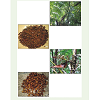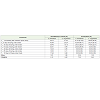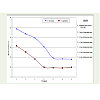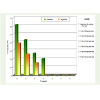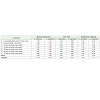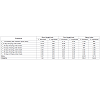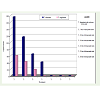Research Article
Influence of Seed Moisture Content on SeedGermination and Quality in Canes
Shivaraj S Patil, Krishna A*
Department of Forest Biology and Tree Improvement, College of Forestry, Sirsi-581 401, University of Agricultural Sciences,Dharwad, Karnataka, India
Corresponding author: Krishna A, Department of Forest Biology and Tree Improvement, College of Forestry,Sirsi-581 401, University of Agricultural Sciences, Dharwad, Karnataka, India; E-mail: krishnaa@uasd.in
Citation: Patil SS, Krishna A. Influence of Seed Moisture Content on Seed Germination and Quality in Canes. J Plant Sci Res. 2016;3(2): 156.
Copyright © Krishna A, et al. 2016. This is an open access article distributed under the Creative Commons Attribution License, which permits unrestricted use, distribution, and reproduction in any medium, provided the original work is properly cited.
Journal of Plant Science & Research | ISSN: 2349-2805 | Volume: 3, Issue: 2
Submission: 18/07/2016; Accepted: 12/08/2016; Published: 17/08/2016
Abstract
A comprehensive laboratory study entitled “Influence of seed moisture on germination and seed quality in in Canes: Calamus thwaitesii and Calamusnagabettai” was undertaken at the Department of Forest Biology and Tree Improvement, College of Forestry, Sirsi, During 2014-15.The initial fruit moisturecontent was 48.72 per cent and 31.52 per cent and the germination of fresh fruits was found to be 61.33 and 38.66 per cent in Calamus thwaitesii andCalamus nagabettai respectively. Subsequently there was much difference in germination per cent in response to reduction in moisture content while dryingthe seeds. Significantly higher moisture content was observed in fresh seeds in both the species i.e. immediately after collection. Lowest moisture contentwas observed in seeds dried for 30 days drying under shade. The moisture content of 30.61 per cent and 18.15 per cent was found to be critical moisturecontent for seeds as below this germination was zero in Calamus thwaitesii and Calamus nagabettai respectively. Higher germination (61.33 per cent) andgermination parameters were observed in seeds immediately after collection (T1). The lowest germination (20.00 per cent) was observed in seeds dried for15 days drying under shade (T4) in Calamus thwaitesii. In Calamus nagabettai , T1 treatment recorded significantly higher germination (38.66 per cent). Thelowest germination (14.66 per cent) was observed in seeds dried for 10 days drying under shade (T3). In general, moisture content of seeds was decreasedwith increasing drying period and leads to decline in seed germination and seed quality parameters in both the species and effect was more pronounced inCalamus nagabettai compared to Calamus thwaitesii.
Keywords: Moisture content; Germination viability; Vigour index
Introduction
Rattans are climbing palms belonging to the family Arecaceae(Palmae). Wood of rattans is strong, with medium density, yet muchlighter than other hardwoods and extremely pliable. Because of thesedesirable characters, it is extensively used in the manufacture of awide range of furniture and handicrafts items for low, medium andhigh end markets [1]. It is a major non-wood forest product aftertimber in South East Asia. The rattan industry has become a laborintensive and rural (or forest) based with increasing prospects forearning foreign exchange. The severe depletion in the rattan resourcesresulted in an urgent need for effective conservation and propagation measures to be taken. The available resources in Karnataka arescarce to meet the demands of the cane industry creating a wide gapbetween demand and supply. But this can be reduced by augmentingthe existing resources by large scale cultivation of canes in the State.The demand for nursery grown seedlings has increased manifold forplanting under social forestry programme and massive afforestationprogramme taken up by the government agencies. Lack of standardnursery techniques hinders such attempts. Even poor naturalregeneration, low rate of seed germination makes the situation worstin case of certain Cane species. Rattan resource is getting depletedconsiderably due to over exploitation and reduction in habitats [2].Planting in natural habitat without disturbing the existing vegetation is a simple way to increase the rattan resource. The large scalecultivation warrants detailed knowledge of propagation methods andtheir growth attributes.
Moisture content is a decisive factor in maintenance ofrecalcitrant seed quality. In these seeds, the sub cellular water isstrangely associated with macromolecular surfaces, assuring thestability of membranes and macromolecules. Water loss during thedrying process causes the series of metabolic alterations, acting onthe control of growth regulators, amount and type of proteins andsugars, presence of free radicals, physical water status, among others,resulting in the onset of the deterioration process. This moisture wastermed as critical moisture content when a significant reduction ingermination percent was observed and as lethal moisture contentwhen no germination occurs [3]. Rattans are the economicallyimportant recalcitrant species which lose their viability within fewdays under natural conditions, when the seed moisture contentreduces below a high critical value. The seeds of some species willnot tolerate any slight change in its desiccation level, that are termedas recalcitrant while others will survive to far lower rate of moisturecontent is orthodox seeds [4]. Storage environment is obviously veryimportant in extending the life of seeds. The ideal metabolic rate instorage will conserve as much of the stored food reserves in the seedsas possible, yet operate at a level that maintains the integrity of theembryos. Although, seeds are propagated virtually no systematicwork has been done either for their multiplication or to know thecauses for their dormancy and poor germination. There is a need tostudy influence of seed moisture content on seed germination andquality in Canes in enhance the seed quality for better and quickgermination.
Material and Methods
A natural population of Calamus thwatesii was identified in asemi- evergreen forest of Katagal forest range, Honnavar division,Uttara Kannada in the month of April and Calamus nagabettai wasidentified in evergreen forest of Kukke Subramanya, Sulllia taluk inDakshina Kannada in the month of July (Plate-1). The fruits wererandomly collected from ten mature mother trees, when the fruitcolour turns to yellow. Soon after collection, the fruits were broughtto the laboratory in gunny bags, processed to get clean, pure seedsof high physiological quality. The outer coat of the fruit is extractedby manual pressing; the fruits are macerated and thoroughly washedunder running water to remove all pulp that is adhered to the fruit.Finally the seed is allowed to air dry in laboratory condition. Sincethe difference in the seed collection period, the experiments wereconducted separately. Immediately after collection fruits outer coatremoved in the laboratory. After seed processing, seeds were driedunder shade in a well-ventilated place to study the effect of moisturecontent on seed germination. For each treatment, 400 seeds were usedand samples were drawn in random in every five days interval up to30 days of shade drying in both the species. In each sample, 100 seedswere used for moisture analysis and other three hundred were usedfor sowing in three replications in the nursery bed for germinationtest. Aftercare like watering and weeding was done regularly in thebeds as and when required throughout the experimental period. Asample of 15- 20 seeds course grinded and same was subjected for oven for 80 °C for 17 hours then seed moisture content was recordedfor both the species. Seed moisture content test was carried out byoven dry method as per the procedures of ISTA [5]. The experimentwas conducted using complete randomized design (CRD) designwith three replication in both the species separately.
Plate 1: A View of (A) Calamas thwaitesii (B) fruits of Calamas thwaitesii (C)Calamas nagabettai tree in natural habitat (D) fruits of Calamas nagabettai.
The treatment details are as follows
T1 : Immediately after collection (Fresh seed)
T2 : 5 days drying under shade
T3 : 10 days drying under shade
T4 : 15 days drying under shade
T5 : 20 days drying under shade
T6 : 25 days drying under shade
T7 : 30 days drying under shade
Results and Discussion
The data on seed moisture content of Calamus thwaitesii andCalamus nagabettai as influenced at different drying intervals arepresented in the Table 1 and depicted in Figure 1. Moisture contentwas significantly influenced by the treatments of different dryingintervals. Moisture content of seeds was decreased with increasingdrying period of seeds. Significantly higher moisture content of 48.72 per cent was observed in fresh seeds of Calamus thwaitesii i.e.immediately after collection (T1). Lowest moisture content (17.94per cent) was observed in seeds dried for 30 days drying under shade(T7). The moisture content of 30.61 per cent was found to be criticalmoisture content for seeds as below this germination was zero. Freshseeds (i.e. immediately after collection) (T1) of Calamus nagabettairecorded higher moisture content (31.52 per cent). Lower seedmoisture content (9.80 per cent) was observed in seeds dried for 30days drying (T7). The moisture content of 18.15 per cent was found tobe critical moisture content. Critical levels of moisture content varygreatly among species and even among cultivars and seed lots [6].These results are in line with the finding of Merlin and Palanisamy [7]who studied seed viability and storability of Jackfruit and Chacko andPillai in Garcinia gummi-gutta [8].
Table 1: Influence of seed drying on seed moisture content and seed germination in C. thwaitesii and C. nagabettai.
Significantly higher seed germination (61.33 per cent) wasobserved in seeds immediately after collection (T1) (Figure 2). Thelowest germination (20.00 per cent) was observed in seeds dried for 15 days drying under shade (T4) in Calamus thwaitesii. However, theseeds dried for 20 days (T5) under shade, 25 days drying (T6), and 30days drying under shade (T7) recorded zero per cent of germination.In Calamus nagabettai fresh seeds (T1) recorded significantly highergermination (38.66 per cent) and low (14.66 per cent) was in seedsdried for 10 days drying under shade (T3). In general, moisture contentof seeds was decreased with increasing drying period of seeds andleads to decline in seed germination. These results were augmentingwith the findings of Broschat and Donselman in the tropical species(Dypsis lutescens,) [9].
Maximum speed of germination value of 1.32 was observedin freshly collected seeds of Calamus thwaitesii (T1) followed bytreatment (T2) for 5 days drying under shade (0.99) (Table 2). Thelowest speed of germination of (0.35) was recorded in treatment (T4)for 15 days drying. Statistically the treatment T1 and T2 were on parwith each other. In case of Calamus nagabettai the maximum speedof germination value of 0.81was observed in freshly collected seed Significantly higher peak values were observed in freshly collectedand de-coated seed (T1) and lowest was in T4. Treatment in boththe species during experimentation. Significantly higher dry weight(0.23g) was noticed in freshly collected de-coated seed (T1). The lowerseedling drying weight (0.15g) was observed in 15 days drying undershade (T4) in Calamus thwaitesii. In case of Calamus nagabettai thehigher dry weight (0.73 g) was observed in freshly collected de-coatedseed (T1) followed by treatment (T2) 5 days drying under shade duringexperimentation. Similar results were also reported by Ezumah in theMelia dubia.
Table 2: Influence of seed drying on speed of germination, peak value and root length in C. thwaitesii and C. nagabettai
Higher shoot length and shoot length was observed in fresh seedsi.e. immediately after collection (T1) than control (Table 3). Lowestshoot length was observed in seeds dried for 15 days drying undershade (T4) in Calamus thwaitesii and Calamus nagabettai.
There was significant variation in seedling vigour index due tomoisture levels in Canes species (Figure 3). The species Calamus thwaitesii recorded higher vigour index of 1754 followed by treatment(T2) 5 days drying. The lower vigour index of 407 was observed inthe treatment of 15 days drying under shade (T4). Similar trend wasnoticed in Calamus nagabettai. These results were augmenting withthe findings of Singh et al., in Azadirachta indica [10-12].
Table 3: Influence of seed drying on shoot length, seedling dry weight and vigour index in C. thwaitesii and C. nagabettai
References
- Renuka C (1992a) Rattans - Their diversity, in habit and habitat. In : Rattan Management and Utilisation. Ed. Chand and Bhat, Proceedings of Rattan Seminar in India, Trichur, pp. 82-85.
- Lakhsmana AC (1993) Rattans of South India. Evergreen publishers, Bengaluru.
- Cibele CM, Bovi MLA, Nakagawa J (2003) Desiccation effects on germination and vigor of King palm seeds. Hort Brasileira 21: 88-92.
- Vargheese B, Naithani SC (2000) Desiccation induced loss of viability and viability during storage in Neem (Azadirachta indica A. Juss) seeds. Seed Sci Tech 26: 485-496.
- Anonymous (1996) International Rules for Seed Testing. Seed Sci Tech 24 (Supplement): 1-335.
- King MW, Roberts EH (1980) The desiccation response of seeds of Cedrus limon L. Ann Bot 45: 489-492.
- Merlin SJ, Palanisamy V (2000) Seed viability and storability of Jack fruit (Artocarpus heterophyllus L.). Seed Res 28: 166-170.
- Chacko KC, Pillai PKC (1997) Seed characteristics and germination on Garcinia gummi-gutta (L.) Robs. Indian For 16: 255-260.
- Broschat TK, Donselman H (1986) Factors Affecting Storage and Germination of Chrysalidocarpus lutescens, seeds. J Amer Soc Hort Sci 111: 872-877.
- Singh BG, Mahadevan NP, Santhi K, Manimuthu L, Geetha S (1997) Effect of moisture content on the viability and storability of Azadirachta indica seeds. Indian For 123: 631-636.
- Singh B, Bhatt BP, Prasad P (2009) Effect of storage period on seed germination of Celtis australis L. In Central Himalayas India. Indian J Agrofor 11: 62-65.
- Roberts EH (1973) Predicting the storage life of seeds. Seeds Sci Technol 499-514.

